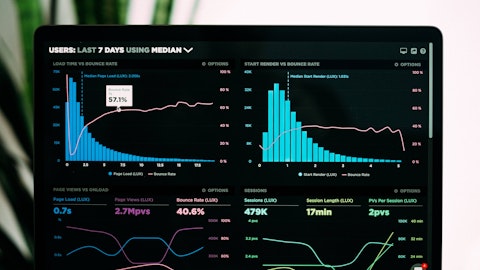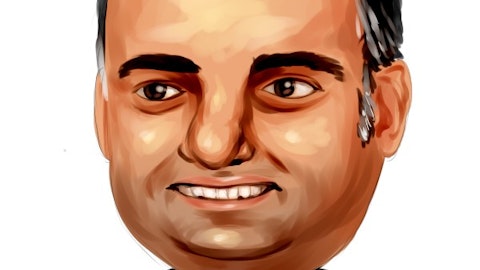That permit is making its way through the process. I think we said last quarter that we anticipated about a 12-month turnaround time on that. So by the time this market really starts gaining steam here domestically, we expect to be fully permitted and able to make those investments if we make the decision to do so.
Arun Viswanathan: Thanks.
Operator: Thank you. Your next question comes from the line of Bill Peterson from JP Morgan. Please go ahead.
Bill Peterson: Yes. Hi. Good morning. Thanks for taking the questions. And Marcel, best wishes as you as you move ahead here. On utilization. So we saw it come down again quarter-on-quarter given the demand environment. I guess can you provide some color on the puts and takes here? Is Mexico running stronger than Europe and how does your utilization — how do you see that comparing to the industry in this industry average? And just kind of related to the destocking environment, like where do inventories sit at your customer sites relative to norms, which I think is around two or three months.
Marcel Kessler: Yes. So let me start with the customer inventory levels and then I’ll come back around to talk about the utilization rates. The sequential decline in global steel production and the constrained industry utilization rates have really limited the ability of customers to significantly drive down their electrode inventory to typical levels. You know for perspective, it varies across the industry, but we generally estimate that customers maintain about three months of electrode inventory on average. And based on the recent channel checks, we believe it’s currently averaging a little bit closer to four months, which is not significantly different from where it was a quarter ago. Although one of the things we’re starting to see Bill is a divergence by region.
In Europe, we’ve seen inventory levels decrease and are actually now below the average that I mentioned. This is really driven by customers continuing to work through the existing inventory, albeit at lower utilization rate. And many customers displaying continued reluctance to purchase of different additional electrodes due to ongoing economic uncertainty there. Conversely in the U.S. inventory levels are above the average and frankly, we think that some of this is partly attributable to some U.S. based steelmakers locking in larger commitments a year ago due to uncertainties related to our situation. Additionally, in the U.S. we are seeing tempered utilization rates which while above the global average are still below the recent history and that’s preventing them from burning through some of these excess inventory that they have.
With specific regard to the utilization rates, we do certainly try to utilize assets closest to where the demand is and that does drive utilization rates in North America higher than what we’re seeing in Europe at 47%. Global utilization rates that does put us pretty much on par with what we’re seeing out of the Tier 1 competitors in the rest of the world with the exception that we do think that their utilization rates in North America are currently running higher than ours for those same market dynamics that I just talked about.
Bill Peterson: Okay. That’s good color. It dovetails in the question on a competitive landscape. You’ve talked about competitors in China and India and some of the direct impacts, I guess Middle East and indirect Europe, but I guess drilling down to your core US and EU markets, hoping to get some further color specifically on the U.S. we’re hearing at least one India based competitor looking to gain share in the U.S. market and then in Europe. I mean, are you seeing signs of China and India-based competitors there. I guess where do you see your differentiation here I guess as we — how should we think about that vis-a-vis the suppliers coming from these regions?
Marcel Kessler: Yes. No, that’s a good question and again the market certainly is competitive. I think the first thing that we have to keep in mind both in the U.S. and Europe, you’ve got trade protections in place against the Chinese imports in both markets and then Indian imports into Europe. Albeit given the situation that occurred in Monterey probably opened the door for customers to potentially qualify new suppliers, Indian suppliers in particular. We still feel confident about what we deliver in terms of a total value proposition to our customers, not just lowest cost supply but high-quality electrodes. The ancillary services that we provide in terms of furnace monitoring and our CTS group. So all of those things I think we feel positioned us very well from a competitive standpoint in both of those markets.
The rest of the world, certainly, it’s a much more cost-oriented and price-oriented market than North America and Europe and that’s the pressure that we’re seeing now in the marketplace.
Bill Peterson: Okay. Yeah. Thanks for that color. And guess lastly on this challenging environment. You still saw — we still saw a strong working capital unwind. How should we think about a similar release in the fourth quarter? And then guess maybe more importantly, could you talk about the puts and takes as we move into 2024, assuming maybe demand improves at least maybe more later in the year? I guess specifically under the working capital, how should we think about the cadence of payables and inventory days as shipments hopefully again improving again?
Marcel Kessler: Yes. So as I think about Q4, right? We did make the comment that we expect to be free cash flow positive for the year. I think we expect some further releases of working capital in the fourth quarter. Jeremy and Tim have done a really good job of bringing inventories down. There’s probably still some opportunities for that to come down further. As we noted also we’re starting to Seadrift here later in the fourth quarter. So we’re still working down existing needle coke inventories from where they are today. So still will be some release of working capital going forward. But I’d also comment that we’re not taking them down to levels beyond what we think is necessary to fulfill customer demand for next year. So as we start to look out, we want to make sure that we have a manageable level of inventory on hand.
Certainly, as production were to ramp up next year. You have some additional buying and procurement activities that go on and you also have a build of your receivables based. So there will be a little bit of use of working capital that I would foresee in 2024.



